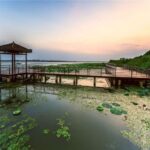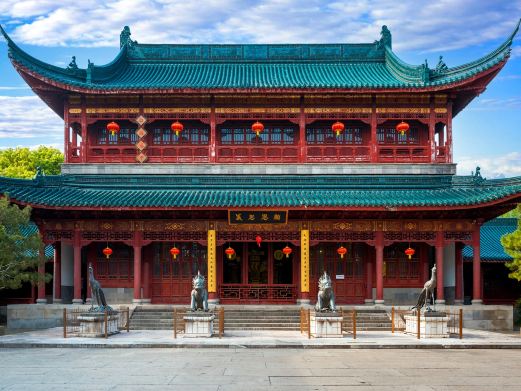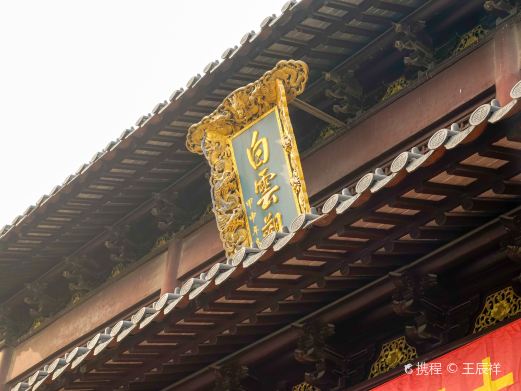The Fengqiao Scenic Area is located on the canal west of the ancient city of Suzhou. The main tourist attractions include Fengqiao Bridge, Tieling Pass, Fengqiao Ancient Town, and the ancient canal (a section of the Beijing-Hangzhou Grand Canal). Zhang Ji’s poem ‘Mooring by Maple Bridge at Night’ in the Tang Dynasty has attracted countless tourists to come and reminisce since ancient times, experiencing the ethereal artistic conception of hearing the bell from Hanshan Temple under the Fengqiao Bridge.
It should be emphasized that although many people say that the Fengqiao Scenic Area includes Hanshan Temple, these two are really not one scenic spot and they sell tickets separately unkindly. The affiliated scenic spots of the Fengqiao Scenic Area occupy most of the area of the scenic area. They are basically on Jiangfengzhou, which is long and thin in the north-south direction. Jiangfengzhou is connected to the land by a bridge. To the east is Hanshan Temple, separated by a not-wide river. Tieling Pass and Hanshan Temple are on the same bank. Together with Fengqiao Bridge adjacent to Tieling Pass, they are located at the northwest corner outside Hanshan Temple. There are three entrances to the scenic area. The Heshan Entrance in the south is closer to Heshan Road and Jinmen Road. The Jiangcun Bridge Entrance in the middle is near the mountain gate of Hanshan Temple. As soon as you enter the Tieling Pass Entrance in the north, you will see the main attractions Tieling Pass and Fengqiao Bridge. The bus stop is on Jinmen Road. Therefore, tourists who come by bus are recommended to enter from the Heshan Entrance. Otherwise, they will have to walk a long way along the outside wall to reach the other two entrances. Tourists who drive or take a taxi can park their cars in the east square of Hanshan Temple scenic area and then enter directly from the Tieling Pass Entrance to head straight for the key points. To the south of Jiangfengzhou is a green belt with a few gardens and halls sparsely opened up. To the north is Fengqiao Ancient Town, all newly built in antique style. There was indeed an ancient town here before. Because it is the intersection of the canal and the ancient post road, merchants gathered. It was extremely prosperous in the Ming and Qing Dynasties and was later destroyed by war. You can visit several exhibition halls in the town. See ship models in the Canal Transport Exhibition Hall, see art exhibitions in Jiangfeng Academy, and the miniature model ‘Scenic Spots of Fengqiao’ in Fengqiao Garden reproduces the prosperous scene of Fengqiao area in the Ming and Qing Dynasties. Several bridges are also worth noting. Jiangcun Bridge near the mountain gate of Hanshan Temple is an ancient bridge rebuilt in the Qing Dynasty. It is said that ‘jiangfeng’ in the sentence ‘Maple trees by the river and fishing fires opposite, making me sleepless with sorrow’ refers to maple trees by the river on one hand, and Jiangcun Bridge and Fengqiao Bridge on the other. The wooden corridor bridge, Listening to the Bell Bridge, is a good place to take pictures of Fengqiao Bridge and Tieling Pass. Under the archway at the northern end of the entire Jiangfengzhou, Jinghong Ferry, you can see the busy scene of ships coming and going on the ancient canal. There is a cargo ship dock on the sloping opposite bank. Not far east from Listening to the Bell Bridge is Fengqiao Bridge. In front of Fengqiao Bridge, there are several steps facing the river. It is said that this is where Zhang Ji moored at night. The construction date of Fengqiao Bridge is unknown. What we see now is rebuilt in 1867 (the sixth year of Tongzhi in the Qing Dynasty). Walk on this single-arch stone arch bridge. The stone steps of the bridge extend all the way into the doorway of Tieling Pass. The stone steps are worn smooth and the edges are pitted. You can clearly feel the passage of time, so that the numerous tourists leave marks on the stones.Tie Ling Guan, originally constructed in the 36th year of the Jiajing era of the Ming Dynasty (AD 1557), stands as one of the surviving anti-Japanese fortifications in Suzhou. The stone base of Tie Ling Guan remains an ancient relic from the Ming and Qing dynasties, with ivy covering it, as if narrating the mottled history. The pavilions on top of the pass are reconstructed in modern times. Visitors can ascend the narrow staircase to the top of the pass, from where they can overlook the ancient town of Fengqiao and gaze at the Puming Pagoda of Hanshan Temple.
If you have purchased a combined ticket for admission and Pingtan boat tour, you can board the boat at the dock below Tie Ling Guan, which leisurely traverses through the bridge archways, allowing one to experience the feeling of ‘arriving at a guest boat.’ Additionally, the boat offers Pingtan performances. To reach Hanshan Temple, cross the ancient street filled with handicrafts, Hanshan Temple Alley, south of Tie Ling Guan, and within less than 100 meters, you will arrive at the entrance of Hanshan Temple. Alternatively, crossing Jiangcun Bridge on Jiangfengzhou, one can see Hanshan Temple from the bridge, and it’s just a short walk away. Operating hours are from 07:30 to 21:00 all year round. Service facilities include a parking lot: [Fengqiao Parking Lot] with a reference price of ¥6 per hour; Address: Fengqiao Road, Gusu District, Suzhou City, Jiangsu Province; Spaces: 50.









